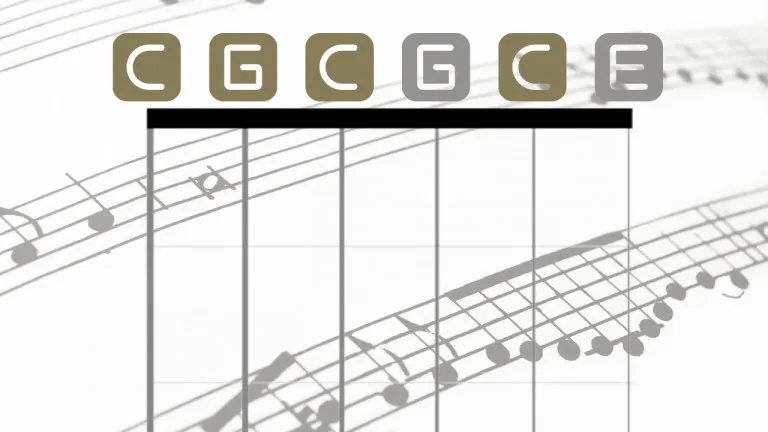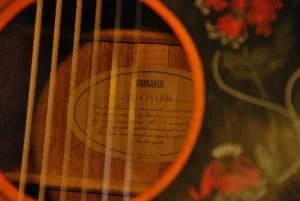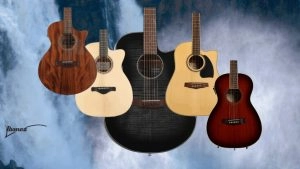The guitar world! A vast ‘open sea’ filled with infinite melodies and sounds waiting to be discovered by guitarists worldwide.
However, while most guitarists have used the basic standard guitar tuning in their exploits, there are but a few ‘guitar warriors’ who have sought the aid of alternative guitar tunings in pursuit of the ultimate melodic revelation. Over time this breed of guitarists has come to be known as the ‘Chosen ones!’

Behold! You are not here by mistake — you might just be one of the few remaining ‘Chosen ones.’ To assist you in your journey, here is an informative guide on one of the many alternative guitar tuning systems out there: open C tuning.
You will find that some guitar chords are more straightforward to play in open C tuning (or other open tunings) than in standard tuning. (All of this is true as long as you don’t play a 7-string guitar!)
How Do I Tune My Guitar to Open C? Simple How-To Guide
First off, a brief discussion on what open C tuning is. As the name suggests, this is where you adjust your string pitches so that when strummed together without fretting, the open strings sound like a C triad chord.
Since a C triad chord only has three notes (C E G) and the guitar has six strings, some of the notes may be doubled or even tripled. The upside is that you can replicate similar fingerings on the same root note with different strings.
There are a few variations to this tuning, consisting of the same three notes arranged and distributed differently on the strings. Equally, some variations may add notes that are not necessarily in a C triad chord. Yet, the most popular arrangement of the open C tuning is C G C G C E.
Now that you know what open C tuning is all about, let’s get to the how.
Steps to Tune with a Tuner
The quickest and most accurate way is to use a tuner to get to the specific string note destinations. It’s also easier if you are used to tuning the guitar to standard tuning.

- Assuming you are in standard tuning, adjust the low E string two whole tones down to a C note.
- Proceed to the A string and adjust it a whole step down to G.
- Move to the D string (fourth string) and tune it a whole step down to C.
- Good job so far! Now leave the G string (third string) as it is.
- You are almost there; tune the B string (second string) half a step up to C.
- Leave the E string (first string) as it is.
- Finally, do a quick confirmation run of each string from lowest to highest (string 6-1) to confirm that the strings are arranged ‘C G C G C E.’
Tuning to Open C by Ear
Don’t have a guitar tuner around? No worries, assuming your guitar is already in standard tuning, you could use the notes on the guitar as reference points to get to target individual string destinations.
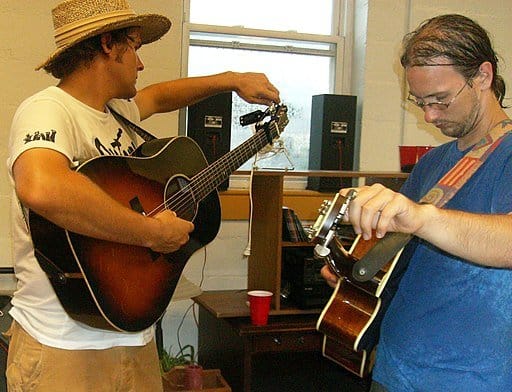
This method requires some degree of good ear skills and works as an excellent way to practice your relative pitch skills.
- Play the note on the third fret of the A (fifth) string, this is a C note. Using this as your reference pitch, tune your E (sixth) string down to match this pitch. Note that the C you are aiming for on the E string will be an octave lower than that on the third fret of the A string.
- The A (fifth) string needs to be tuned a step down to G, so you can use the G on the open third string as a reference point. The G you’re aiming at on the fifth string is an octave lower than the one on the open third string.
- Now play the open sixth string (now C) to get a reference for what the fourth (D) string should sound like as you adjust it a whole step down to get to C (this will be an octave higher than the sixth string)
- Leave the G string as it is.
- Use the open fourth string’s C as a reference note to tune the B string (second string) half step up to C (this will be an octave higher than the fourth string)
- Finally, leave the E string as it is.
- Good work! Once you finish, you can strum all the open strings of the now-tuned guitar to confirm you landed on the proper pitches. This should sound like a C major triad chord, full — resolved, bright, and complete when properly tuned.
• • •
Open C Tuning Chords
Surely, you realize the extreme power radiating from your guitar by strumming the open C major chord produced by the open strings.
However, strumming only the C chord on repeat will limit your ability to discover the melodies and sounds hidden within this mysterious dark art. Therefore, you will need to learn new chords to help you take advantage of this new tuning.
Here’s a quick guide to play chords in open C tuning to kick start your musical exploration.
Open C Major Chord Shapes
Given that simply strumming the open strings of your guitar in this tuning gives you a major chord (C major), it should come as no surprise that major chords are pretty easy to play in open C tuning.
Playing a Whole Fret Barre in Open C Tuning
Apart from playing the open string C major chord, single barring only the notes within individual frets will allow you to play chords with one finger. To get the name of the major chord sounded, one simply has to look at the note pressed on the sixth string, which gives you the chord name.
Here are a few of such fretted major chords:
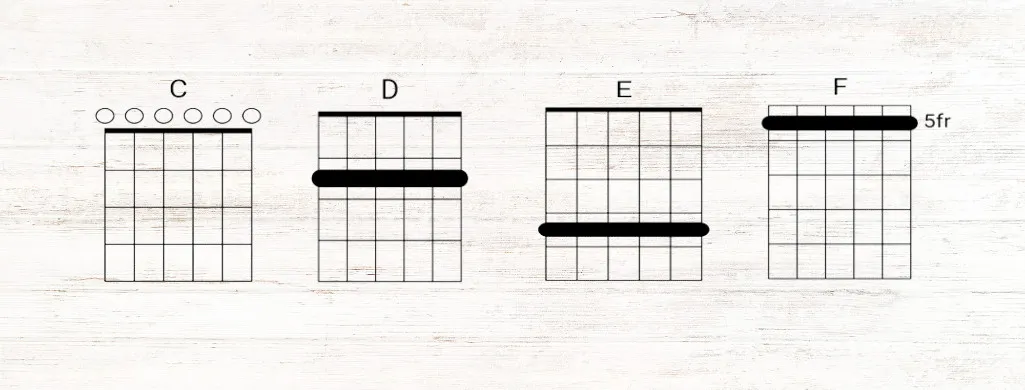
Part Fret Major Chords
There are also variations of chords in major triads that are not single-finger fretted. These are also movable across the fretboard. Below are a few samples:
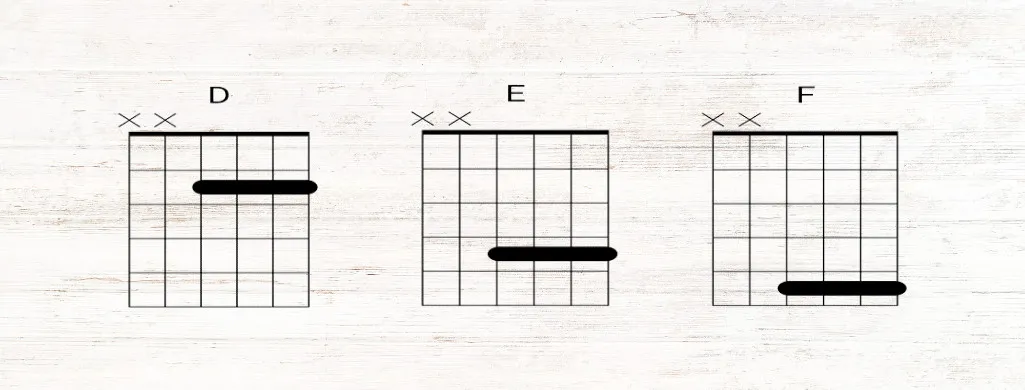
Open C Minor Chords
Like with major chords, there are a variety of voicings for minor chords (1) that you can employ in open C tuning. Most of these are movable too, although less so than the major chords.
Here are a few examples of fingerings that you can try across the fretboard to get different minor chords:
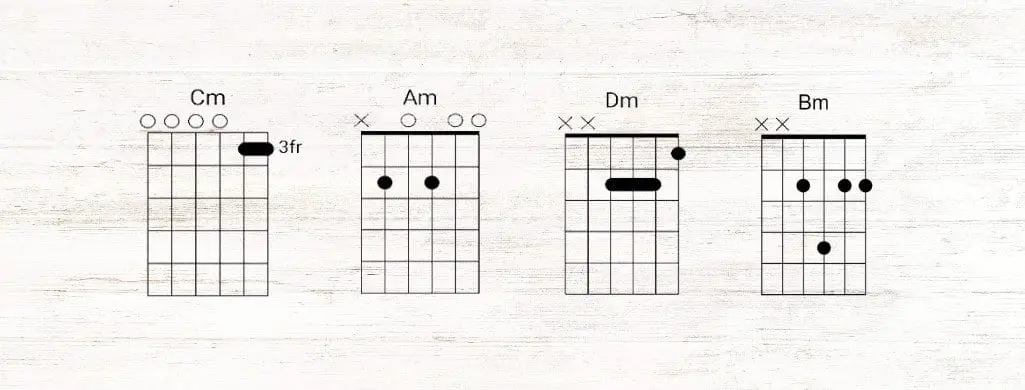
Open C 7th Chords
To add a little spice to your playing, you might need some 7th chords in your music, and there are various ways you could achieve this. You can use the following shapes to create these essential chords.
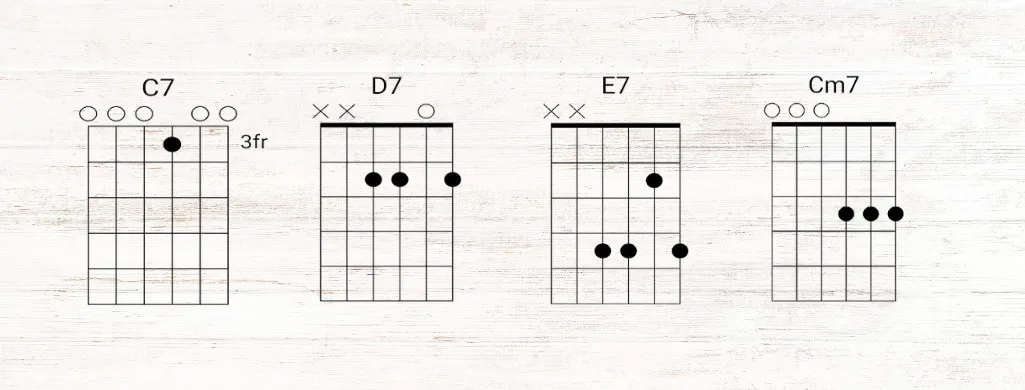
Open C Tuning Open Chords
Open chords simply refer to chords that include unfretted string notes for guitar playing. There are various variations found within the open C tuning, which can be pretty helpful in one’s playing. Here are some examples:
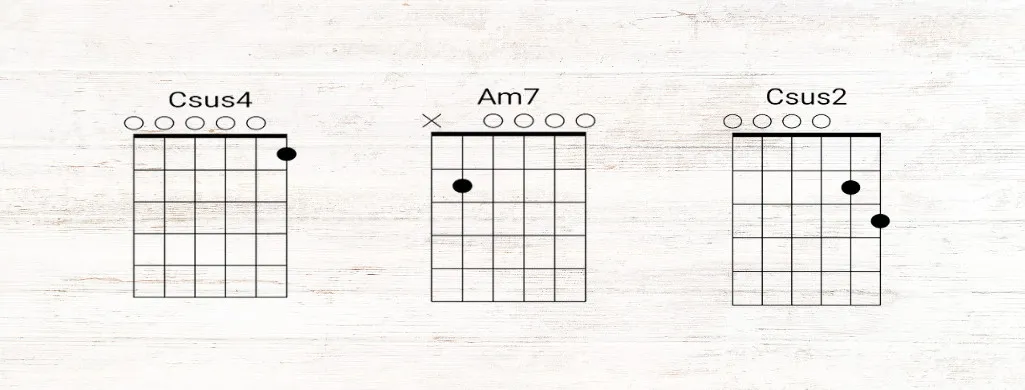
• • •
Scales in Open C Tuning
So, now you have a good grasp of open C chords and would like to incorporate some lead lines and licks.
How about trying out some scale patterns to help you memorize the fretboard and make your playing more interesting.
It is important to note that the patterns used in standard tuning will not work in open C tuning. Equally, in open C tuning, you will not find the convenient placing of notes that allow fluid note-to-note movements on standard tuning.
Major scales in Open C tuning
A major scale is a seven-note scale consisting of a specific succession of whole steps and half steps. The pattern of a major scale is; whole step, whole step, half step, whole step, whole step, whole step, half step. Here’s an example:
C- D- E- F- G- A- B- C
That’s the C major scale, and you can numerically represent it as 1 2 3 4 5 6 7.
To play a major scale, simply pick any note on the fretboard and follow this succession of steps to create a major scale pattern.
You can then use these scales to create unique bright-sounding licks and riffs to add some flavor to your music. Below are the natural notes as they appear on the guitar fretboard when using open C Tuning.
To flatten a note, you simply have to lower it by a semitone. In contrast, raising a note by a semitone will sharpen it.
Minor Scales in Open C tuning
While resourceful, major scales may not be able to assist you in creating those emotion-evoking, sad, eerie, and suspenseful songs you might need. To do that, you need minor scales.
Like major scales, minor scales also have seven notes, only this time, the steps involved in the succession of notes differ.
There are three types of minor scales.
- Natural minor: The pattern for this is whole step, half step, whole step, whole step, half step, whole step, whole step.
- Harmonic minor: The harmonic minor is similar to the natural minor the only difference is a semitone raises the 7th. So, the last note is 1.5 steps up from the previous one.
- Melodic minor: If the natural and harmonic minor scales were to have a child, it would be the melodic minor scale. This has a little bit of both. It is similar to the harmonic minor scale when ascending, only adding a raised sixth note. When descending, melodic minor scales are the same as natural minor scales.
Below is a diagram showing all the natural and sharpened notes found on the guitar in open C tuning. Using your knowledge of minor scales, you can develop minor scale patterns that will aid you in your musical creations.
• • •
Songs That Use Open C Tuning
There’s hardly a better way to grasp what open C tuning is all about than learning some of the most iconic songs that make use of it. So let’s see some examples.
1. “Friends” by Led Zeppelin
Among the most highly regarded by hardcore Led Zeppelin fans, this was one of the songs that told the world Led Zeppelin was not ‘just a rock band.’ Seeing that you just learned open C tuning, perhaps this is just the song to let everyone know you are more than ‘just a standard tuning guitarist.’
The band’s guitarist, Jimmy Page, used an open C6 tuning which is simply a variation of the open C tuning with an added A note. Just replace the G note on the fifth string with an A. This will result in the pitches of the strings being C A C G C E.
• • •
2. “Little Lion Man” by Mumford & Sons
A guitarist named Mumford, a dude named Sons, and a little lion walk into a bar. The bartender looks at the lion and says, “what can I get you, little man?”
Featuring mostly easy chords and quite fast strumming on the guitar parts, Little Lion Man was the debut song for the band Mumford and Sons, released in 2009. The song surprised many as it performed well commercially and charted in many countries worldwide.
You will need to have a capo on the fifth fret and open C tuning to play the song.
• • •
3. “Burden In My Hands” by Sound Garden
The riffs, the insane bass line, the lyricism, and the incredible vocals… it’s hard to pick what to love about this song the most. If you are looking for an excellent place to start using open C on an electric guitar, this might be it.
The song uses an alternate open C tuning replacing the C on the second string with a G so that the strings are tuned C G C G G E.
• • •
4. “Skinny Love” by Bon Iver
Bon Iver is an American indie-folk band founded in 2007 by musician Justin Vernon. While Vernon wrote the song and released it in the band’s debut studio album For Emma, Forever Ago, Ed Sheeran also released a version of this song on YouTube that was quite popular.
• • •
5. “Amelia” by Joni Mitchell
Regarded as the mother of alternate tunings by some guitarists, musician Joni Mitchell loved using alternate tunings in her songs. In describing the songwriting process, she states that she wrote the song on a solitary cross-country travel thinking of pioneering female aviator Amelia Earhart.
The six-minute song was first featured on Mitchell’s 1976 album Hejira, changing between two keys (F major and G major) and never genuinely resolving. The entire piece is built on a 23-bar loop with the time signature switching between 3/4 and 4/4 on the last seven bars.
While the guitar’s open C tuning adds melodic richness to the song, Mitchell’s rhythmic fingerpicking sets its foundation.
• • •
6. “King of Spain” by The Tallest Man On Earth
This song featured in the debut album The Wild Hunt, released in 2010. Kristian showcases his natural, distinct, folky-vocal prowess, his voice following the playing of the guitar and rising at the chorus.
Using open C tuning and a capo on the 8th fret, “King of Spain” demonstrates beautifully the three main elements needed to make a good folk tune; voice, instrument, and lyric.
• • •
7. “Caledonia” by Dougie MacLean
Released in 1983, this is arguably one of the most recognizable songs in Scotland. “Caledonia” was written by a homesick Dougie MacLean while he was at a beach in France. Since then, Dougie has continued to build his international fame as an exceptional songwriter and musician. Most of Scotland embraces his hit song as a musical symbol of Scottish pride.
All you need is to get your guitar tuned to open C and have a capo on the 4th fret.
• • •
8. “Deadhead” by Townsend Project
You probably might need some black eye shadow and a complete head-to-toe black outfit to play this one. Nothing says “Ultimate Guitar Warrior” like an eight-minute progressive metal rock song packed with cool riffs, a fantastic head-banging drum line, and epic, screaming vocals.
Make sure you have an electric guitar for this one.
Deadhead was released in the 2003 Accelerated Evolution album.
• • •
9. “Bleeding Love” by Boyce Avenue
Initially composed by Jesse McCartney and Ryan Tedder, The X Factor winner Leona Lewis released Bleeding Love in 2007 as her breakthrough song.
Years later, the song still “slapped,” and American cover band Boyce Avenue added to the song’s extraordinary record, this time on an acoustic guitar.
With a single note playing at the beginning of the song, building into simple fingerpicking of open chords, and transitioning into easy rhythmic strumming, this is a good song for beginners.
• • •
10. “Sister Awake” by The Tea Party
The Tea Party is a Canadian rock band known for their intriguing, unique style, more popularly known as the “Moroccan Roll.” This is a result of the various influences from which the group drew inspiration, including progressive rock, Indian, and Middle Eastern music
“Sister Awake” is one of the most erotic yet empowering songs written by The Tea Party. The song was released in 1995, featuring as the 4th song in the group’s The Edges of Twilight album.
• • •
11. “Question” by Moody Blues
Staying on the UK charts for 12 weeks straight after its release as a single in 1970, “Question” remains Moody Blues’ second-highest charting song to date. Guitarist Justin Hayward wrote it and also sang the lead vocals.
The song alternates between a fast-paced strumming section with a recurring baseline melody and a separate slower section featuring dramatic changes.
• • •
12. “You Are Not Alone” by Michael Jackson
Think about this for a moment: a fantastic song performed by one of the most excellent musicians to have ever graced this planet… and it uses open C tuning!
It features beautiful chord voicings to accompany Michael Jackson’s incredible vocals.
• • •
13. “Ocean” by John Butler
Employing various guitar techniques such as hammer-ons, pull-offs, fingerstyle picking, and percussive taps, this is a good song for intermediate to advanced guitarists.
Purely an instrumental work, the composer, mostly known for his band, the John Butler Trio, opts for a twelve-string guitar instead of the typical six-string guitar. This provides a unique layering effect brought about by the doubling of each string. But you can still play it on a six-string.
• • •
14. “The Fear” by Ben Howard
Have you ever heard a song that just gets you all psyched up and yearning to “just live” and be the best version of yourself? “The Fear” by Ben Howard is just that!
It’s In open C tuning and with a capo on the 4th fret.
• • •
15. “Bron – Y – Aur Stomp” by Led Zeppelin
Appearing for the second time on this list is the English rock band Led Zeppelin with their 1970 release, “Bron- Y- Aur Stomp.” Robert Plant wrote the song for his dog, Strider.
The song uses an alternate open C tuning, replacing the fifth string’s G note with an A. This will go down as one of the greatest songs written about a dog.
• • •
16. “Shrike” by Hozier
Demonstrating symbolism in music, Irish musician Hozier uses the Shrike bird as a metaphor for strength after surviving the heartbreak of a toxic relationship.
Released in 2019, Shrike was the eighth track in Hozier’s Wasteland, Baby! album. The song is in 3/4 timing employing some cool guitar techniques such as fingerpicking, hammer-ons, and pull-offs in the intro, which is the most challenging part.
Though it sounds easy, it would be wise for beginner guitarists to take this as slow as possible when learning it.
• • •
17. “Only for the Weak” by In Flames
In Flames is a Swedish heavy metal band founded in 1990 by guitarist Jesper Stromblad. “Only for the Weak” was the third track in their 2000 album Clayman.
Do not be deceived by the song’s name; the tune is packed with multiple cool riffs and an epic solo that you can blast on your amp. However, you might want to check in with your neighbors to confirm they are cool with the loud music.
• • •
18. “Betterman” by John Butler Trio
A true master in alternate tuning compositions, John Butler appears again on this list with his Australian band, John Butler Trio.
Betterman was the 1st track of the group’s 2001 second album release, Three. In his distinctive singing style, Butler portrays the story of a woman from a previous relationship that changed his life but, in the end, just proved to be too good for him. From doing a lot of tours across Australia, the song continued to gain popularity and is nowadays a “must play” in live performances by the group.
Tuned to standard open C tuning (C G C G C E), the song features a cool repeated riff at the beginning and builds into a beautiful solo that lasts for over 3 minutes. The John Butler Trio has plenty of songs in open tunings, so check them out.
• • •
19. Silver Lining by Mt. Joy
Lead singer of Mt Joy Matt Quinn wrote the song in reaction to the many drug-related deaths he saw in his hometown of Philadelphia.
With its simple strumming patterns and easy chord fingerings, this serves as a good starting point for beginner guitarists looking for a break from complex standard tuning chords. The song also features a beautiful vocal part that could serve as an excellent exercise to practice your singing while accompanying yourself.
• • •
20. “Only Love” by Ben Howard
We figured that in a musical world filled with many songs that use open C tuning, “Only Love” can complete our list.
With a simple guitar acting as accompaniment for his unique, rich, full-of-feeling singing, Howard delivers a heartwarming description of his “Only Love.”
Tune your guitar to Open C tuning and place a capo on the third fret to play this. He uses a “pick a go” technique on this song which you can learn from here:
• • •
Other Songs in Open C tuning
- “Independence Day” by Elliot Smith
- “Pretty Noose” by Sound garden
- “Can’t Get Enough” by Bad Company
- “Time 2” by Ewan Hobson
- “Final Passage” by Al Petteway
- “Ballad of Big Nothing” by Elliot Smith
- “Wind and Walls” by the Tallest Man on Earth
- “I Will Wait” by Mumford and Sons
• • •
Final Thoughts
As you embark into the vast guitar world, don’t be afraid to experiment with different tunings. Remember, while the open C tuning packs a lot of power with it, the ultimate guitar power lies in expressing a good balance of what is in one’s heart and mind when playing.
• • •
References
- MasterClass.com, “How to Use Chord Voicing in Music,” as published here https://www.masterclass.com/articles/how-to-use-chord-voicing-in-music
Image Credits
Man tuning a guitar image: @photosbyphab, CC0, via Wikimedia Commons; Two men tuning guitars image: Artaxerxes, CC BY-SA 3.0, via Wikimedia Commons.

